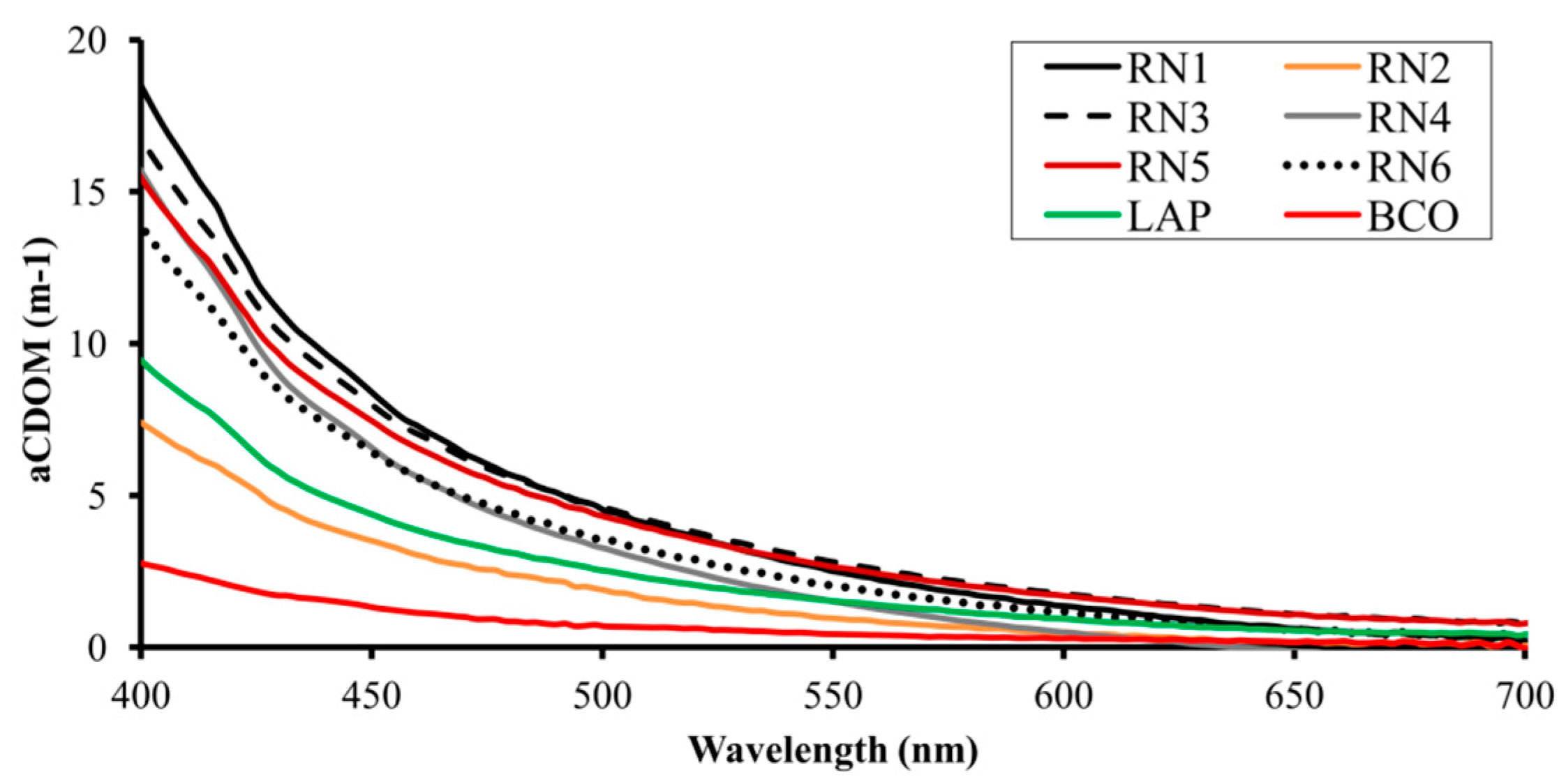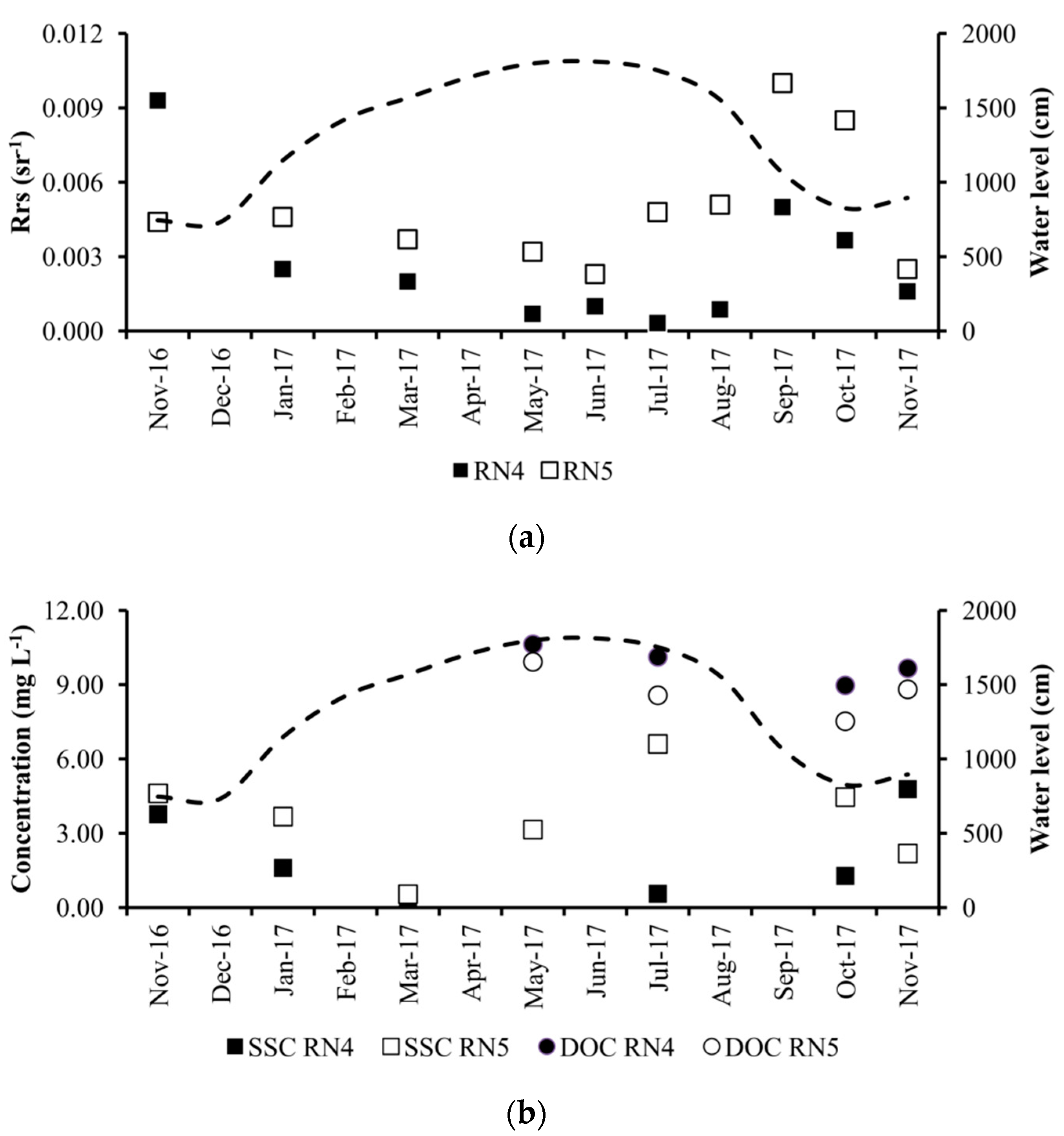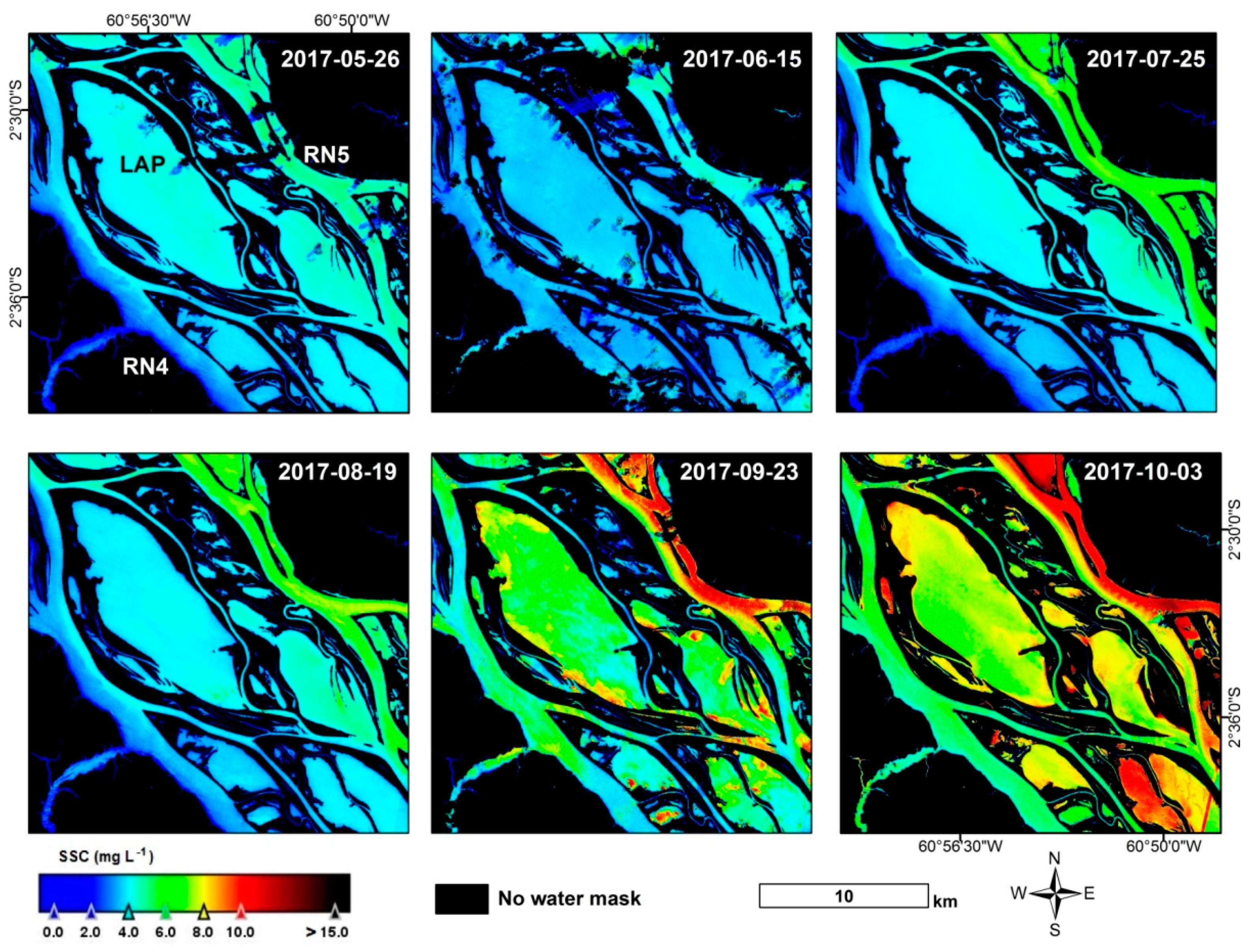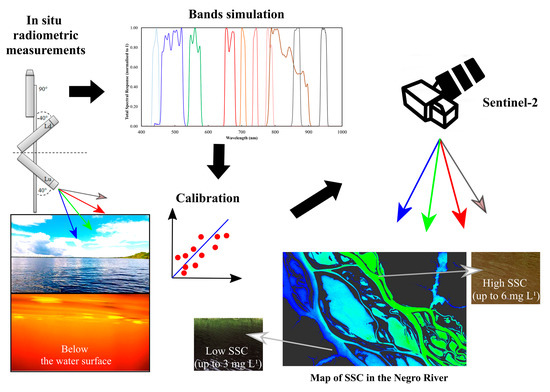Spatiotemporal Dynamics of Suspended Sediments in the Negro River, Amazon Basin, from In Situ and Sentinel-2 Remote Sensing Data
Abstract
:1. Introduction
2. Materials and Methods
2.1. Study area
2.2. In situ Data Collection
2.2.1. Radiometry
2.2.2. Water Quality
2.3. Models for Estimating SSC
2.4. Satellite Data and Processing
3. Results
3.1. Water Composition from in situ Data
3.2. Relationships between Rrs and Water Quality
3.2.1. Multispectral MSI Simulated Bands Correlation with SSC and DOC
3.2.2. SSC Estimations Based in Sentinel-2 MSI Simulated Bands
3.3. SSC Spatiotemporal Variability from Satellite Imagery
4. Discussion
4.1. Suspended Sediment Transport in an Anabranching River
4.2. Use of Passive Satellite Remote Sensing for SSC Monitoring in the Negro River
5. Conclusions
Supplementary Materials
Author Contributions
Funding
Institutional Review Board Statement
Informed Consent Statement
Data Availability Statement
Acknowledgments
Conflicts of Interest
References
- Gupta, A. Large Rivers; Gupta, A., Ed.; John Wiley & Sons, Ltd.: Chichester, UK, 2007; ISBN 9780470723722. [Google Scholar]
- Latrubesse, E.; Stevaux, J.; Sinha, R. Tropical rivers. Geomorphology 2005, 70, 187–206. [Google Scholar] [CrossRef]
- Allen, P.A. From landscapes into geological history. Nature 2008, 451, 274–276. [Google Scholar] [CrossRef] [Green Version]
- Bakker, M.M.; Govers, G.; van Doorn, A.; Quetier, F.; Chouvardas, D.; Rounsevell, M. The response of soil erosion and sediment export to land-use change in four areas of Europe: The importance of landscape pattern. Geomorphology 2008, 98, 213–226. [Google Scholar] [CrossRef]
- Hinderer, M. From gullies to mountain belts: A review of sediment budgets at various scales. Sediment. Geol. 2012, 280, 21–59. [Google Scholar] [CrossRef]
- Kuhn, C.; de Matos Valerio, A.; Ward, N.; Loken, L.; Sawakuchi, H.O.; Kampel, M.; Richey, J.; Stadler, P.; Crawford, J.; Striegl, R.; et al. Performance of Landsat-8 and Sentinel-2 surface reflectance products for river remote sensing retrievals of chlorophyll-a and turbidity. Remote Sens. Environ. 2019, 224, 104–118. [Google Scholar] [CrossRef] [Green Version]
- Mouw, C.B.; Greb, S.; Aurin, D.A.; Digiacomo, P.M.; Lee, Z.; Twardowski, M.S.; Binding, C.; Hu, C.; Ma, R.; Moore, T.S.; et al. Aquatic color radiometry remote sensing of coastal and inland waters: Challenges and recommendations for future satellite missions. Remote Sens. Environ. 2015, 160, 15–30. [Google Scholar] [CrossRef]
- Palmer, S.C.; Kutser, T.; Hunter, P.D. Remote sensing of inland waters: Challenges, progress and future directions. Remote Sens. Environ. 2015, 157, 1–8. [Google Scholar] [CrossRef] [Green Version]
- Bukata, R.P. Satellite Monitoring of Inland and Coastal Water Quality: Retrospection, Intropection, Future Direction; Taylor & Francis Group: Boca Raton, FL, USA, 2005. [Google Scholar]
- Gholizadeh, M.H.; Melesse, A.M.; Reddi, L. A Comprehensive review on water quality parameters estimation using remote sensing techniques. Sensors 2016, 16, 1298. [Google Scholar] [CrossRef] [Green Version]
- Doherty, M. Climate missions to come. In Climate Change & Satellites: Knowledge for Action; Cracknell, G., Calvaud, R., Roca, R., Eds.; Sud[s] Concepts: Paris, France, 2015. [Google Scholar]
- Agência Nacional de Águas (ANA). HidroSat—Monitoramento Hidrológico por Satélite. Available online: http://hidrosat.ana.gov.br/ (accessed on 29 December 2018).
- SO-HYBAM. Observation Service SO HYBAM. Available online: http://www.ore-hybam.org (accessed on 29 December 2018).
- UNESCO. The Unesco-IHP IIWQ World Water Quality Portal. Available online: www.worldwaterquality.org (accessed on 17 April 2020).
- Crétaux, J.-F. Ocean and inland Waters. In Climate Change & Satellites: Knowledge for action; Cracknell, G., Calvaud, R., Roca, R., Eds.; Sud[s] Concepts: Paris, France, 2015. [Google Scholar]
- de Lucia Lobo, F.; de Moraes Novo, E.M.L.; Barbosa, C.C.F.; Galvão, L.S. Reference spectra to classify Amazon water types. Int. J. Remote Sens. 2012, 33, 3422–3442. [Google Scholar] [CrossRef]
- Maciel, D.; Novo, E.; de Carvalho, L.S.; Barbosa, C.; Júnior, R.F.; de Lucia Lobo, F. Retrieving total and inorganic suspended sediments in Amazon floodplain lakes: A multisensor approach. Remote Sens. 2019, 11, 1744. [Google Scholar] [CrossRef] [Green Version]
- Martinez, J.-M.; Espinoza-Villar, R.; Armijos, E.; Silva Moreira, L. The optical properties of river and floodplain waters in the Amazon River Basin: Implications for satellite-based measurements of suspended particulate matter. J. Geophys. Res. Earth Surf. 2015, 120, 1274–1287. [Google Scholar] [CrossRef]
- Montanher, O.C.; Novo, E.M.L.M.; Barbosa, C.C.; Rennó, C.D.; Silva, T.S. Empirical models for estimating the suspended sediment concentration in Amazonian white water rivers using Landsat 5/TM. Int. J. Appl. Earth Obs. Geoinf. 2014, 29, 67–77. [Google Scholar] [CrossRef]
- Pinet, S.; Martinez, J.-M.; Ouillon, S.; Lartiges, B.; Villar, R.E. Variability of apparent and inherent optical properties of sediment-laden waters in large river basins—lessons from in situ measurements and bio-optical modeling. Opt. Express 2017, 25, A283. [Google Scholar] [CrossRef] [PubMed]
- Gibbs, R.J. The geochemistry of the Amazon River System: Part I. The factors that control the salinity and the composition and concentration of the suspended solids. GSA Bull. 1967, 78, 1203–1232. [Google Scholar] [CrossRef]
- Leenheer, J.A. Origin and nature of humic substances in the waters of the Amazon River Basin. Acta Amaz. 1980, 10, 513–526. [Google Scholar] [CrossRef] [Green Version]
- Richey, J.E.; Hedges, J.I.; Devol, A.H.; Quay, P.D.; Victoria, R.; Martinelli, L.; Forsberg, B.R. Biogeochemistry of carbon in the Amazon River. Limnol. Oceanogr. 1990, 35, 352–371. [Google Scholar] [CrossRef]
- Filizola, N.P. Transfert Sédimentaire Actuel par les Fleuves Amazoniens. Ph.D. Thesis, Paul Sabatier University, Toulouse, France, 2003. [Google Scholar]
- Moreira-Turcq, P.; Seyler, P.; Guyot, J.L.; Etcheber, H. Exportation of organic carbon from the Amazon River and its main tributaries. Hydrol. Process. 2003, 17, 1329–1344. [Google Scholar] [CrossRef]
- Abril, G.; Martinez, J.-M.; Artigas, L.F.; Moreira-Turcq, P.; Benedetti, M.F.; Vidal, L.; Meziane, T.; Kim, J.-H.; Bernardes, M.C.; Savoye, N.; et al. Amazon River carbon dioxide outgassing fuelled by wetlands. Nature 2013, 505, 395–398. [Google Scholar] [CrossRef]
- Filizola, N.; Guyot, J.-L.; Wittmann, H.; Martinez, J.-M.; Oliveira, E. The significance of suspended sediment transport determination on the Amazonian hydrological scenario. In Sediment Transport in Aquatic Environments; InTech: Rijeka, Croatia, 2011; pp. 45–64. [Google Scholar]
- Latrubesse, E.M.; Arima, E.Y.; Dunne, T.; Park, E.; Baker, V.R.; D’Horta, F.M.; Wight, C.; Wittmann, F.; Zuanon, J.; Baker, P.A.; et al. Damming the rivers of the Amazon basin. Nature 2017, 546, 363–369. [Google Scholar] [CrossRef]
- Lobo, F.L.; Costa, M.P.F.; Novo, E.M.L.M. Time-series analysis of Landsat-MSS/TM/OLI images over Amazonian waters im-pacted by gold mining activities. Remote Sens. Environ. 2015, 157, 170–184. [Google Scholar] [CrossRef]
- Winemiller, K.O.; McIntyre, P.B.; Castello, L.; Fluet-Chouinard, E.; Giarrizzo, T.; Nam, S.; Baird, I.G.; Darwall, W.R.T.; Lujan, N.K.; Harrison, I.; et al. Balancing hydropower and biodiversity in the Amazon, Congo, and Mekong. Science 2016, 351, 128–129. [Google Scholar] [CrossRef] [PubMed] [Green Version]
- Doxaran, D.; Froidefond, J.-M.; Lavender, S.; Castaing, P. Spectral signature of highly turbid waters. Remote Sens. Environ. 2002, 81, 149–161. [Google Scholar] [CrossRef]
- Mertes, L.A.; Daniel, D.L.; Melack, J.M.; Nelson, B.; Martinelli, L.A.; Forsberg, B.R. Spatial patterns of hydrology, geomorphology, and vegetation on the floodplain of the Amazon river in Brazil from a remote sensing perspective. Geomorphology 1995, 13, 215–232. [Google Scholar] [CrossRef]
- Nechad, B.; Ruddick, K.G.; Park, Y. Calibration and validation of a generic multisensor algorithm for mapping of total sus-pended matter in turbid waters. Remote Sens. Environ. 2010, 114, 854–866. [Google Scholar] [CrossRef]
- Novo, E.; Hansom, J.; Curran, P. The effect of viewing geometry and wavelength on the relationship between reflectance and suspended sediment concentration. Int. J. Remote Sens. 1989, 10, 1357–1372. [Google Scholar] [CrossRef]
- Bernardo, N.; Alcântara, E.; Watanabe, F.; Rodrigues, T.; Imai, N.; Curtarelli, M.; Barbosa, C. Bio-optical model tuning for retrieving the total suspended matter concentration in Barra Bonita reservoir. Rev. Bras. Cartogr. 2015, 67, 1497–1507. [Google Scholar]
- Chelotti, G.B.; Martinez, J.M.; Roig, H.L.; Olivietti, D. Space-Temporal analysis of suspended sediment in low concentration reservoir by remote sensing. Braz. J. Water Resour. 2019, 24, 1–15. [Google Scholar] [CrossRef] [Green Version]
- Gallay, M.; Martinez, J.; Allo, S.; Mora, A.; Cochonneau, G.; Gardel, A.; Doudou, J.; Sarrazin, M.; Chow-Toun, F.; Laraque, A. Impact of land degradation from mining activities on the sediment fluxes in two large rivers of French Guiana. Land Degrad. Dev. 2018, 29, 4323–4336. [Google Scholar] [CrossRef]
- Marinho, T.; Filizola, N.; Martinez, J.-M.; Armijos, E.; Nascimento, A. Suspended sediment variability at the Solimões and Negro confluence between May 2013 and February 2014. Geosciences 2018, 8, 265. [Google Scholar] [CrossRef] [Green Version]
- Yepez, S.; Laraque, A.; Martinez, J.-M.; De Sa, J.; Carrera, J.M.; Castellanos, B.; Gallay, M.; Lopez, J.L. Retrieval of suspended sediment concentrations using Landsat-8 OLI satellite images in the Orinoco River (Venezuela). Comptes Rendus Geosci. 2018, 350, 20–30. [Google Scholar] [CrossRef]
- Knaeps, E.; Ruddick, K.; Doxaran, D.; Dogliotti, A.; Nechad, B.; Raymaekers, D.; Sterckx, S. A SWIR based algorithm to retrieve total suspended matter in extremely turbid waters. Remote Sens. Environ. 2015, 168, 66–79. [Google Scholar] [CrossRef] [Green Version]
- Curran, P.J.; Hansom, J.D.; Plummer, S.E.; Pedley, M.I. Multispectral remote sensing of nearshore suspended sediments: A pilot study. Int. J. Remote Sens. 1987, 8, 103–112. [Google Scholar] [CrossRef]
- Novoa, S.; Doxaran, D.; Ody, A.; Vanhellemont, Q.; Lafon, V.; Lubac, B.; Gernez, P. Atmospheric corrections and multi-conditional algorithm for multi-sensor remote sensing of suspended particulate matter in low-to-high turbidity levels coastal waters. Remote Sens. 2017, 9, 61. [Google Scholar] [CrossRef] [Green Version]
- Espinoza-Villar, R.; Martinez, J.-M.; Armijos, E.; Espinoza, J.-C.; Filizola, N.; Dos Santos, A.; Willems, B.; Fraizy, P.; Santini, W.; Vauchel, P. Spatio-temporal monitoring of suspended sediments in the Solimões River (2000–2014). Comptes Rendus Geosci. 2018, 350, 4–12. [Google Scholar] [CrossRef]
- Espinoza Villar, R.; Martinez, J.-M.; Le Texier, M.; Guyot, J.-L.; Fraizy, P.; Meneses, P.R.; de Oliveira, E. A study of sediment transport in the Madeira River, Brazil, using MODIS remote-sensing images. J. South Am. Earth Sci. 2013, 44, 45–54. [Google Scholar] [CrossRef]
- Dos Santos, A.L.M.R.; Martinez, J.M.; Filizola, N.P.; Armijos, E.; Alves, L.G.S. Purus River suspended sediment variability and contributions to the Amazon River from satellite data (2000–2015). Comptes Rendus Geosci. 2018, 350, 13–19. [Google Scholar] [CrossRef]
- Martinez, J.-M.; Guyot, J.; Filizola, N.; Sondag, F. Increase in suspended sediment discharge of the Amazon River assessed by monitoring network and satellite data. Catena 2009, 79, 257–264. [Google Scholar] [CrossRef] [Green Version]
- Montanher, O.C.; de Moraes Novo, E.M.L.; de Souza Filho, E.E. Temporal trend of the suspended sediment transport of the Amazon River (1984–2016). Hydrol. Sci. J. 2018, 63, 1901–1912. [Google Scholar] [CrossRef]
- Kutser, T.; Paavel, B.; Verpoorter, C.; Ligi, M.; Soomets, T.; Toming, K.; Casal, G. remote sensing of black lakes and using 810 nm reflectance peak for retrieving water quality parameters of optically complex waters. Remote Sens. 2016, 8, 497. [Google Scholar] [CrossRef]
- Marinho, R.R.; Filizola Junior, N.P.; Cremon, É.H. Analysis of suspended sediment in the Anavilhanas Archipelago, Rio Negro, Amazon Basin. Water 2020, 12, 1073. [Google Scholar] [CrossRef] [Green Version]
- Espinoza Villar, R.E.; Martinez, J.-M.; Guyot, J.-L.; Fraizy, P.; Armijos, E.; Crave, A.; Bazán, H.; Vauchel, P.; Lavado, W. The integration of field measurements and satellite observations to determine river solid loads in poorly monitored basins. J. Hydrol. 2012, 444–445, 221–228. [Google Scholar] [CrossRef]
- Pereira, F.J.S.; Costa, C.A.G.; Foerster, S.; Brosinsky, A.; De Araújo, J.C. Estimation of suspended sediment concentration in an intermittent river using multi-temporal high-resolution satellite imagery. Int. J. Appl. Earth Obs. Geoinf. 2019, 79, 153–161. [Google Scholar] [CrossRef]
- Latrubesse, E.M.; Stevaux, J.C. The Anavilhanas and Mariuá Archipelagos: Fluvial wonders from the Negro River, Amazon Basin. In Landscapes and Landforms of Brazil; Vieira, B.C., Salgado, A.A.R., Santos, L.J.C., Eds.; Springer: Dordrecht, The Netherlands, 2015; pp. 157–169. [Google Scholar]
- Filizola, N.; Guyot, J.L. Suspended sediment yields in the Amazon basin: An assessment using the Brazilian national data set. Hydrol. Process. 2009, 23, 3207–3215. [Google Scholar] [CrossRef]
- Sander, C.; Gasparetto, N.V.L.; dos Santos, M.L.; de Carvalho, T.M. Características do transporte de sedimentos em suspensão na bacia do Rio Branco, Estado de Roraima. Acta Geográfica 2014, 8, 71–85. [Google Scholar]
- Filizola, N.; Guyot, J.L. Fluxo de sedimentos em suspensão nos rios da Amazônia. Rev. Bras. Geociências 2011, 41, 566–576. [Google Scholar] [CrossRef]
- Junk, W.J.; Wittmann, F.; Schöngart, J.; Piedade, M.T.F. A classification of the major habitats of Amazonian black-water river floodplains and a comparison with their white-water counterparts. Wetl. Ecol. Manag. 2015, 23, 677–693. [Google Scholar] [CrossRef]
- Meade, R.H.; Nordin Jr, C.F.; Curtis, W.F.; Rodrigues, F.M.C.; Vale, C.M.D.; Edmond, J.M. Transporte de sedimentos no rio Amazonas. Acta Amaz. 1979, 9, 543–547. [Google Scholar] [CrossRef]
- Quesada, C.A.; Lloyd, J.; Anderson, L.O.; Fyllas, N.M.; Schwarz, M.; Czimczik, C.I. Soils of Amazonia with particular reference to the RAINFOR sites. Biogeosciences 2011, 8, 1415–1440. [Google Scholar] [CrossRef] [Green Version]
- Moquet, J.-S.; Guyot, J.-L.; Crave, A.; Viers, J.; Filizola, N.; Martinez, J.-M.; Oliveira, T.C.; Sánchez, L.S.H.; Lagane, C.; Casimiro, W.S.L.; et al. Amazon River dissolved load: Temporal dynamics and annual budget from the Andes to the ocean. Environ. Sci. Pollut. Res. 2015, 23, 11405–11429. [Google Scholar] [CrossRef] [Green Version]
- Sioli, H. The Amazon and its main affluents: Hydrography, morphology of the river courses, and river types. In Amazon Limnology and Landscape Ecology of Mighty Tropical River and Its Basins; Sioli, H., Ed.; Springer: Dordrecht, The Netherlands, 1984; pp. 127–165. [Google Scholar]
- Forsberg, B.R.; Devol, A.H.; Richey, J.E.; Martinelli, L.A.; Dos Santos, H. Factors controlling nutrient concentrations in Amazon floodplain lakes. Limnol. Oceanogr. 1988, 33, 41–56. [Google Scholar] [CrossRef]
- Scofield, V.; Melack, J.M.; Barbosa, P.M.; Amaral, J.H.F.; Forsberg, B.R.; Farjalla, V.F. Carbon dioxide outgassing from Ama-zonian aquatic ecosystems in the Negro River basin. Biogeochemistry 2016, 129, 77–91. [Google Scholar] [CrossRef]
- Mobley, C.D. Estimation of the remote-sensing reflectance from above-surface measurements. Appl. Opt. 1999, 38, 7442–7455. [Google Scholar] [CrossRef]
- Zibordi, G.; Voss, K.J.; Johnson, B.C.; Mueller, J.L. Protocols for Satellite Ocean Colour Data Validation: In Situ Optical Radiometry; International Ocean Colour Coordinating Group (IOCCG): Dartmouth, NS, Canada, 2019. [Google Scholar]
- Harmel, T.; Gilerson, A.; Tonizzo, A.; Chowdhary, J.; Weidemann, A.; Arnone, R.; Ahmed, S. Polarization impacts on the water-leaving radiance retrieval from above-water radiometric measurements. Appl. Opt. 2012, 51, 8324–8340. [Google Scholar] [CrossRef]
- Gilerson, A.; Carrizo, C.; Foster, R.; Harmel, T. Variability of the reflectance coefficient of skylight from the ocean surface and its implications to ocean color. Opt. Express 2018, 26, 9615–9633. [Google Scholar] [CrossRef]
- Chami, M.; Lafrance, B.; Fougnie, B.; Chowdhary, J.; Harmel, T.; Waquet, F. OSOAA: A vector radiative transfer model of coupled atmosphere-ocean system for a rough sea surface application to the estimates of the directional variations of the water leaving reflectance to better process multi-angular satellite sensors data over the ocean. Opt. Express 2015, 23, 27829–27852. [Google Scholar] [CrossRef] [Green Version]
- Morcrette, J.-J.; Boucher, O.; Jones, L.; Salmond, D.; Bechtold, P.; Beljaars, A.; Benedetti, A.; Bonet, A.; Kaiser, J.W.; Razinger, M.; et al. Aerosol analysis and forecast in the European Centre for Medium-Range Weather Forecasts Integrated Forecast System: Forward modeling. J. Geophys. Res. Atmos. 2009, 114, 06206. [Google Scholar] [CrossRef]
- Lobo, F.L.; Jorge, D.S.F. Processamento de dados, modelagem e mapeamento de parâmetros bio-ópticos. In Introdução ao sensoriamento remoto de sistemas aquáticos. Princípios e aplicações; Barbosa, C.C.F., Novo, E.M.L.M., Martins, V.S., Eds.; Instituto Nacional de Pesquisas Espaciais: São José dos Campos, Brazil, 2019; pp. 82–106. ISBN 978-85-17-00095-9. [Google Scholar]
- Matthews, M.W. A current review of empirical procedures of remote sensing in inland and near-coastal transitional waters. Int. J. Remote Sens. 2011, 32, 6855–6899. [Google Scholar] [CrossRef]
- Dorji, P.; Fearns, P.; Broomhall, M. A semi-analytic model for estimating total suspended sediment concentration in turbid coastal waters of Northern Western Australia using MODIS-Aqua 250 m data. Remote Sens. 2016, 8, 556. [Google Scholar] [CrossRef] [Green Version]
- Peterson, K.T.; Sagan, V.; Sidike, P.; Cox, A.L.; Martinez, M. Suspended sediment concentration estimation from landsat imagery along the Lower Missouri and Middle Mississippi rivers using an extreme learning machine. Remote Sens. 2018, 10, 1503. [Google Scholar] [CrossRef] [Green Version]
- Sari, V.; dos Reis Castro, N.M.; Pedrollo, O.C. Estimate of suspended sediment concentration from monitored data of tur-bidity and water level using artificial neural networks. Water Resour. Manag. 2017, 31, 4909–4923. [Google Scholar] [CrossRef]
- Papoutsa, C.; Retalis, A.; Toulios, L.; Hadjimitsis, D.G. Defining the Landsat TM/ETM+ and CHRIS/PROBA spectral regions in which turbidity can be retrieved in inland waterbodies using field spectroscopy. Int. J. Remote Sens. 2014, 35, 1674–1692. [Google Scholar] [CrossRef]
- Luo, Y.; Doxaran, D.; Ruddick, K.; Shen, F.; Gentili, B.; Yan, L.; Huang, H. Saturation of water reflectance in extremely turbid media based on field measurements, satellite data and bio-optical modelling. Opt. Express 2018, 26, 10435–10451. [Google Scholar] [CrossRef] [Green Version]
- Boggs, P.T.; Byrd, R.H.; Rogers, J.E.; Schnabel, R.B. User’s Reference Guide for ODRPACK Version 2.01; U.S. Department of Commerce: Gaithersburg, MD, USA, 1992.
- Mikkonen, S.; Pitkänen, M.R.A.; Nieminen, T.; Lipponen, A.; Isokääntä, S.; Arola, A.; Lehtinen, K.E.J. Technical note: Effects of uncertainties and number of data points on line fitting—A case study on new particle formation. Atmos. Chem. Phys. Discuss. 2019, 19, 12531–12543. [Google Scholar] [CrossRef] [Green Version]
- Volpe, V.; Silvestri, S.; Marani, M. Remote sensing retrieval of suspended sediment concentration in shallow waters. Remote Sens. Environ. 2011, 115, 44–54. [Google Scholar] [CrossRef]
- ESA. Sentinel-2 Spectral Response Functions (S2-SRF). Available online: https://sentinel.esa.int/web/sentinel/user-guides/sentinel-2-msi/document-library/-/asset_publisher/Wk0TKajiISaR/content/sentinel-2a-spectral-responses (accessed on 24 January 2021).
- Drusch, M.; Del Bello, U.; Carlier, S.; Colin, O.; Fernandez, V.; Gascon, F.; Hoersch, B.; Isola, C.; Laberinti, P.; Martimort, P.; et al. Sentinel-2: ESA’s optical high-resolution mission for GMES opera-tional services. Remote Sens. Environ. 2012, 120, 25–36. [Google Scholar] [CrossRef]
- Harmel, T.; Chami, M.; Tormos, T.; Reynaud, N.; Danis, P.-A. Sunglint correction of the Multi-Spectral Instrument (MSI)-SENTINEL-2 imagery over inland and sea waters from SWIR bands. Remote Sens. Environ. 2018, 204, 308–321. [Google Scholar] [CrossRef]
- Rahman, H.; Dedieu, G. SMAC: A simplified method for the atmospheric correction of satellite measurements in the solar spectrum. Int. J. Remote Sens. 1994, 15, 123–143. [Google Scholar] [CrossRef]
- Benedetti, A.; Morcrette, J.-J.; Boucher, O.; Dethof, A.; Engelen, R.J.; Fisher, M.; Flentje, H.; Huneeus, N.; Jones, L.; Kaiser, J.W.; et al. Aerosol analysis and forecast in the European Centre for Medium-Range Weather Forecasts Integrated Forecast System: 2. Data assimilation. J. Geophys. Res. Atmos. 2009, 114, D13205. [Google Scholar] [CrossRef] [Green Version]
- Latrubesse, E.M. Patterns of anabranching channels: The ultimate end-member adjustment of mega rivers. Geomorphology 2008, 101, 130–145. [Google Scholar] [CrossRef]
- Meade, R.H.; Rayol, J.M.; Da Conceicão, S.C.; Natividade, J.R.G. Backwater effects in the Amazon River basin of Brazil. Environ. Geol. Water Sci. 1991, 18, 105–114. [Google Scholar] [CrossRef]
- Fassoni-Andrade, A.C.; de Paiva, R.C.D. Mapping spatial-temporal sediment dynamics of river-floodplains in the Amazon. Remote Sens. Environ. 2019, 221, 94–107. [Google Scholar] [CrossRef]
- Park, E.; Latrubesse, E.M. Modeling suspended sediment distribution patterns of the Amazon River using MODIS data. Remote Sens. Environ. 2014, 147, 232–242. [Google Scholar] [CrossRef]
- Da Silva, M.P.; Sander De Carvalho, L.A.; Novo, E.; Jorge, D.S.F.; Barbosa, C.C.F. Use of optical absorption indices to assess seasonal variability of dissolved organic matter in Amazon floodplain lakes. Biogeosciences 2020, 17, 5355–5364. [Google Scholar] [CrossRef]
- Coelho, C.; Heim, B.; Foerster, S.; Brosinsky, A.; De Araújo, J.C. In situ and satellite observation of CDOM and chlorophyll-a dynamics in small water surface reservoirs in the Brazilian semiarid region. Water 2017, 9, 913. [Google Scholar] [CrossRef] [Green Version]
- Kutser, T.; Casal Pascual, G.; Barbosa, C.; Paavel, B.; Ferreira, R.; Carvalho, L.; Toming, K. Mapping inland water carbon content with Landsat 8 data. Int. J. Remote Sens. 2016, 37, 2950–2961. [Google Scholar] [CrossRef]
- Montero, J.C.; Latrubesse, E.M. The igapó of the Negro River in central Amazonia: Linking late-successional inundation forest with fluvial geomorphology. J. South Am. Earth Sci. 2013, 46, 137–149. [Google Scholar] [CrossRef]
- Scabin, A.B.; Costa, F.R.C.; Schöngart, J. The spatial distribution of illegal logging in the Anavilhanas archipelago (Central Amazonia) and logging impacts on species. Environ. Conserv. 2011, 39, 111–121. [Google Scholar] [CrossRef]
- Martins, V.S.; Barbosa, C.C.F.; Carvalho, L.A.S.; Jorge, D.S.F.; Lobo, F.D.L.; Novo, E.M.L.M. Assessment of atmospheric correction methods for Sentinel-2 MSI images applied to amazon floodplain lakes. Remote Sens. 2017, 9, 322. [Google Scholar] [CrossRef] [Green Version]
- Asner, G.P. Cloud cover in Landsat observations of the Brazilian Amazon. Int. J. Remote Sens. 2001, 22, 3855–3862. [Google Scholar] [CrossRef]
- Dorji, P.; Fearns, P. Impact of the spatial resolution of satellite remote sensing sensors in the quantification of total suspended sediment concentration: A case study in turbid waters of Northern Western Australia. PLoS ONE 2017, 12, e0175042. [Google Scholar] [CrossRef] [PubMed]
- EPE. Usina Hidrelétrica (UHE) Bem Querer. Available online: http://www.uhebemquerer.com.br/ (accessed on 11 December 2018).











| Band | Central Wavelength (nm) | Band Width (nm) | Spatial Resolution (m) |
|---|---|---|---|
| 3 | 560 | 35 | 10 |
| 4 | 665 | 30 | 10 |
| 5 | 705 | 15 | 20 |
| 6 | 740 | 15 | 20 |
| 7 | 783 | 20 | 20 |
| 8a | 865 | 20 | 20 |
| Sample Station | Location | SSC Mean | SSC Range | DOC Mean | DOC Range |
|---|---|---|---|---|---|
| BCO | Branco River | 14.70 | 4.00–22.64 | 6.98 | 4.92–9.93 |
| LAP | Apacú Lake at Anavilhanas | 5.43 | 2.39–8.48 | 8.55 | 6.47–10.43 |
| RN1 | Negro River upstream to Branco River | 4.45 | 2.32–7.61 | 10.64 | 9.54–11.26 |
| RN2 | Negro River downstream to Branco River | 6.18 | 5.73–11.76 | 6.48 | 4.20–10.90 |
| RN3 | Negro River upstream to Anavilhanas | 3.01 | 0.44–6.35 | 10.33 | 8.51–12.74 |
| RN4 | Right bank of the Negro River at Anavilhanas | 3.18 | 0.56–6.15 | 9.85 | 8.92–10.73 |
| RN5 | Left bank of the Negro River at Anavilhanas | 4.02 | 2.18–6.60 | 7.41 | 7.41–10.18 |
| RN6 | Negro River downstream to Anavilhanas | 1.47 | 0.48–3.24 | 8.96 | 7.58–10.31 |
| Sentinel-2 Band | RMSE (mg L−1) | MAPE (%) |
|---|---|---|
| Rrs_sim(B3) | 1.12 | 13.20 |
| Rrs_sim(B4) | 1.41 | 16.38 |
| Rrs_sim(B5) | 1.53 | 16.89 |
| Rrs_sim(B6) | 1.74 | 19.45 |
| Rrs_sim(B7) | 1.81 | 19.99 |
| Rrs_sim(B8a) | 1.70 | 18.63 |
| Rrs_sim(B8a)/Rrs_sim(B4) | 5.26 | 61.99 |
Publisher’s Note: MDPI stays neutral with regard to jurisdictional claims in published maps and institutional affiliations. |
© 2021 by the authors. Licensee MDPI, Basel, Switzerland. This article is an open access article distributed under the terms and conditions of the Creative Commons Attribution (CC BY) license (http://creativecommons.org/licenses/by/4.0/).
Share and Cite
Marinho, R.R.; Harmel, T.; Martinez, J.-M.; Filizola Junior, N.P. Spatiotemporal Dynamics of Suspended Sediments in the Negro River, Amazon Basin, from In Situ and Sentinel-2 Remote Sensing Data. ISPRS Int. J. Geo-Inf. 2021, 10, 86. https://0-doi-org.brum.beds.ac.uk/10.3390/ijgi10020086
Marinho RR, Harmel T, Martinez J-M, Filizola Junior NP. Spatiotemporal Dynamics of Suspended Sediments in the Negro River, Amazon Basin, from In Situ and Sentinel-2 Remote Sensing Data. ISPRS International Journal of Geo-Information. 2021; 10(2):86. https://0-doi-org.brum.beds.ac.uk/10.3390/ijgi10020086
Chicago/Turabian StyleMarinho, Rogério Ribeiro, Tristan Harmel, Jean-Michel Martinez, and Naziano Pantoja Filizola Junior. 2021. "Spatiotemporal Dynamics of Suspended Sediments in the Negro River, Amazon Basin, from In Situ and Sentinel-2 Remote Sensing Data" ISPRS International Journal of Geo-Information 10, no. 2: 86. https://0-doi-org.brum.beds.ac.uk/10.3390/ijgi10020086







